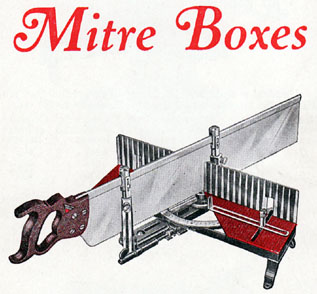Langdon Mitre Box Company
Brought to you by oldtoolheaven.com
 Miter boxes are used by woodworkers to hold a saw in the proper position to make precision cuts at any one of a series of predetermined angles. The basic tool, in use for centuries, was traditionally made of hardwood and built by a workman for his own use. Often constructed as the need arose, the wooden miter box was generally a short-lived affair since frequent use enlarged the slots in which the saw passed, resulting in cuts that became increasingly inaccurate.
Miter boxes are used by woodworkers to hold a saw in the proper position to make precision cuts at any one of a series of predetermined angles. The basic tool, in use for centuries, was traditionally made of hardwood and built by a workman for his own use. Often constructed as the need arose, the wooden miter box was generally a short-lived affair since frequent use enlarged the slots in which the saw passed, resulting in cuts that became increasingly inaccurate.
Leander W. Langdon invented a cast iron miter box in 1864 that remedied many of the shortcomings of the traditional wooden box. It was adjustable to a wide variety of angles, remained accurate after repeated use and, unlike wood, wasn't affected by changes in humidity. A company was formed to manufacture Langdon's invention, but despite its obvious advantages, lackluster marketing and the comparatively high cost of the box relegated it to a niche market. It was not until 1872, when a reorganized Langdon Mitre Box Company made several improvements to the product and began marketing the boxes through the Millers Falls Manufacturing Company that sales started to pick up.
Although the re-designed miter box was more flexible and easier to use than its predecessor, the company faltered in 1875 and was moved from its original home in Northampton, Massachusetts, to the village of Millers Falls. There, under the guidance of David C. and George E. Rogers, production was restarted, new models were developed and the company went on to become the foremost producer of metallic miter boxes in the country. The firm, an independent entity located within the Millers Falls Company factory, enjoyed close links to the much larger operation. George E. Rogers served on the boards of both businesses, and the Millers Falls Company eventually became the sole distributor of the Langdon products. The Langdon Mitre Box Company retained its independence until 1907 when it merged with the Millers Falls Company. Millers Falls continued to develop the line and branded its better miter boxes with the Langdon name until the mid-1970s.
While a metallic miter box is capable of surprisingly accurate cuts, a properly sharpened saw and a good technique are required to get the most out of the tool. The 1881 price list of the Langdon Mitre Box Company includes this bit of advice that holds as true today as it did when written:
All persons using Mitre Boxes should remember that in Sawing Mouldings (at any angle other than right-angle) the saw cuts at an angle partly with the grain of the wood, and is always inclined to follow the grain: To obviate this tendency the handle of the saw should be raised so that the saw shall commence its work as near the back of the Mitre Box as possible, as the saw is less liable to spring when starting near its support. Let the saw rest lightly on the moulding in starting.
The illustration above appeared in a Millers Falls Company brochure issued nearly two decades after the Langdon merger: Mitre boxes: a Mitre Box for Every Purpose. Millers Falls, Mass.: Millers Falls Co., ca. 1925.
Note: With regard to the variant spellings of the word miter, care has been taken to use the contemporary form miter when referring to a tool or to the process of creating an angled cut. From 1872 until 1907, Langdon used the older spelling mitre as part its company name. The author uses the older spelling when referring to the company or when quoting from text in which the older form appears.